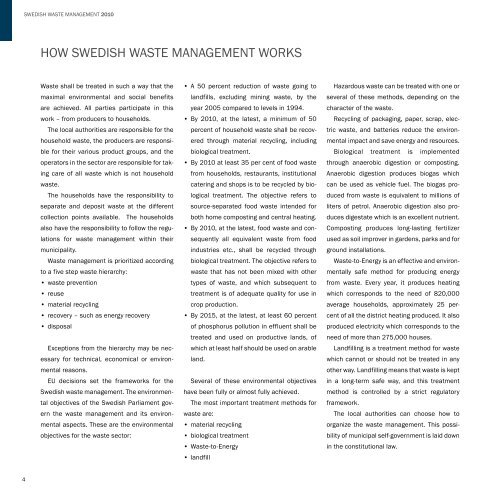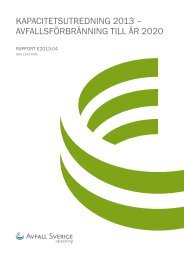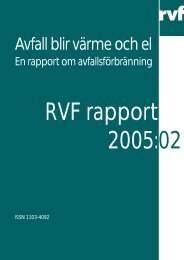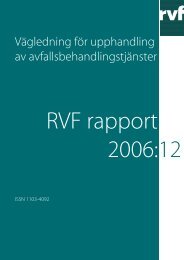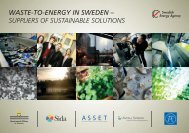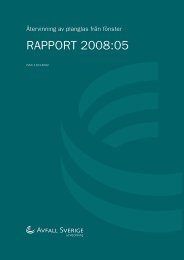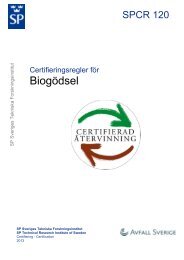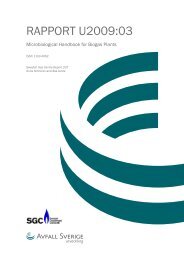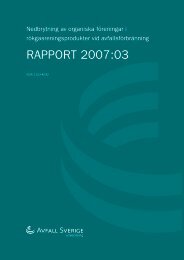SWEDISH WASTE MANAGEMENT |2010 - Avfall Sverige
SWEDISH WASTE MANAGEMENT |2010 - Avfall Sverige
SWEDISH WASTE MANAGEMENT |2010 - Avfall Sverige
Create successful ePaper yourself
Turn your PDF publications into a flip-book with our unique Google optimized e-Paper software.
<strong>SWEDISH</strong> <strong>WASTE</strong> <strong>MANAGEMENT</strong> 2010<br />
HOW <strong>SWEDISH</strong> <strong>WASTE</strong> <strong>MANAGEMENT</strong> WORKS<br />
Waste shall be treated in such a way that the<br />
maximal environmental and social benefits<br />
are achieved. All parties participate in this<br />
work – from producers to households.<br />
The local authorities are responsible for the<br />
household waste, the producers are responsible<br />
for their various product groups, and the<br />
operators in the sector are responsible for taking<br />
care of all waste which is not household<br />
waste.<br />
The households have the responsibility to<br />
separate and deposit waste at the different<br />
collection points available. The households<br />
also have the responsibility to follow the regulations<br />
for waste management within their<br />
municipality.<br />
Waste management is prioritized according<br />
to a five step waste hierarchy:<br />
• waste prevention<br />
• reuse<br />
• material recycling<br />
• recovery – such as energy recovery<br />
• disposal<br />
Exceptions from the hierarchy may be necessary<br />
for technical, economical or environmental<br />
reasons.<br />
EU decisions set the frameworks for the<br />
Swedish waste management. The environmental<br />
objectives of the Swedish Parliament govern<br />
the waste management and its environmental<br />
aspects. These are the environmental<br />
objectives for the waste sector:<br />
• A 50 percent reduction of waste going to<br />
landfills, excluding mining waste, by the<br />
year 2005 compared to levels in 1994.<br />
• By 2010, at the latest, a minimum of 50<br />
percent of household waste shall be recovered<br />
through material recycling, including<br />
biological treatment.<br />
• By 2010 at least 35 per cent of food waste<br />
from households, restaurants, institutional<br />
catering and shops is to be recycled by biological<br />
treatment. The objective refers to<br />
source-separated food waste intended for<br />
both home composting and central heating.<br />
• By 2010, at the latest, food waste and consequently<br />
all equivalent waste from food<br />
industries etc., shall be recycled through<br />
biological treatment. The objective refers to<br />
waste that has not been mixed with other<br />
types of waste, and which subsequent to<br />
treatment is of adequate quality for use in<br />
crop production.<br />
• By 2015, at the latest, at least 60 percent<br />
of phosphorus pollution in effluent shall be<br />
treated and used on productive lands, of<br />
which at least half should be used on arable<br />
land.<br />
Several of these environmental objectives<br />
have been fully or almost fully achieved.<br />
The most important treatment methods for<br />
waste are:<br />
• material recycling<br />
• biological treatment<br />
• Waste-to-Energy<br />
• landfill<br />
Hazardous waste can be treated with one or<br />
several of these methods, depending on the<br />
character of the waste.<br />
Recycling of packaging, paper, scrap, electric<br />
waste, and batteries reduce the environmental<br />
impact and save energy and resources.<br />
Biological treatment is implemented<br />
through anaerobic digestion or composting.<br />
Anaerobic digestion produces biogas which<br />
can be used as vehicle fuel. The biogas produced<br />
from waste is equivalent to millions of<br />
liters of petrol. Anaerobic digestion also produces<br />
digestate which is an excellent nutrient.<br />
Composting produces long-lasting fertilizer<br />
used as soil improver in gardens, parks and for<br />
ground installations.<br />
Waste-to-Energy is an effective and environmentally<br />
safe method for producing energy<br />
from waste. Every year, it produces heating<br />
which corresponds to the need of 820,000<br />
average households, approximately 25 percent<br />
of all the district heating produced. It also<br />
produced electricity which corresponds to the<br />
need of more than 275,000 houses.<br />
Landfilling is a treatment method for waste<br />
which cannot or should not be treated in any<br />
other way. Landfilling means that waste is kept<br />
in a long-term safe way, and this treatment<br />
method is controlled by a strict regulatory<br />
framework.<br />
The local authorities can choose how to<br />
organize the waste management. This possibility<br />
of municipal self-government is laid down<br />
in the constitutional law.<br />
4


